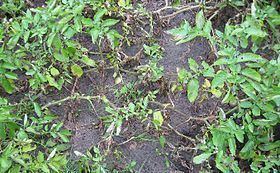Domain Eukaryota Subclass Incertae sedis Family Pythiaceae | Superphylum Heterokonta Rank Species | |
 | ||
Scientific name Phytophthora erythroseptica Similar Phytophthora, Phytophthora cryptogea, Oomycete, Phytophthora drechsleri, Phytophthora megasperma | ||
Phytophthora erythroseptica—also known as pink rot along with several other species of Phytophtora—is a plant pathogen. It infects potatoes (Solanum tuberosum) causing their tubers to turn pink and damages leaves. It also infects tulips (Tulipa) damaging their leaves and shoots.
Contents
Several species from the Phytophthora genus are believed to be involved in causing pink rot-like diseases.
Disease Cycle
As Phytophthora erythroseptica is an oomycete its disease cycle follows that of any other Phytophthora species. Oospores, sporangia and zoospores can infect any part of the potato plant that is below ground. Oospores produced in the field can overwinter and when thawed produce an oogonium and antheridium which will then lead to the production of sporangia, oospores and zoospores. This pathogen can be polycyclic, using sporangia as the secondary inoculum. Often this secondary inoculum infects tubers post harvest while in storage.
This pathogen grows best in a warm and wet environment. It can infect a host without a wound, however the presence of a wound will increase infection greatly. A wound is needed for infection to occur when the tubers are in storage. Very moist fields will have increased rates of infection as the amount of moisture makes it easy for the zoospores to move through the soil and infect tubers.
Symptoms and Host
P. erythroseptica is host specific, and infects only potatoes in moist soils. However there are related pink rot species that infect raspberries, tomatoes, clover and asparagus. The common name of pink rot comes from the fact that when infected tubers are left open to the air they will turn pink. After becoming pink the tubers will turn brown, then black as time goes on. The pink color is often used as the main symptom when making a firm diagnosis. The infected tubers often are watery and have a distinct smell. The potatoes plants themselves can sometimes be wilted however most symptoms are seen on the tuber. The majority of diseased tubers get infected while in storage. The majority of symptoms are seen inside the tuber except for the rubbery appearance that the outside may have. There are often cases that show symptoms other than rotting, these are often due to a pathogen other than P. erythroseptica infecting the tuber along with pink rot.
Management
The most significant factor in control of this pathogen is correct sanitation and cultural practices. A well drained soil and discarding of debris and volunteer potatoes will limit the spread of this pathogen greatly. Since the pathogen needs high levels of moisture in the soil for dissemination, one of the most important factors to watch in controlling this pathogen is the moisture content. The storage of these potatoes should be keep dry and cool in order to prevent spread of the pathogen, and if at all possible reducing the amount of wounds on potatoes will also be beneficial. There is some chemical control procedures involving chemicals such as metalaxyl, are often used but resistance to these kinds of chemicals is starting to grow. Metalaxyl and chemicals like it disrupt RNA polymerase and prevent transcription and is often used around a month before harvest. However, resistance to pink rot is being tested and encouraged in new cultivars of potatoes.
